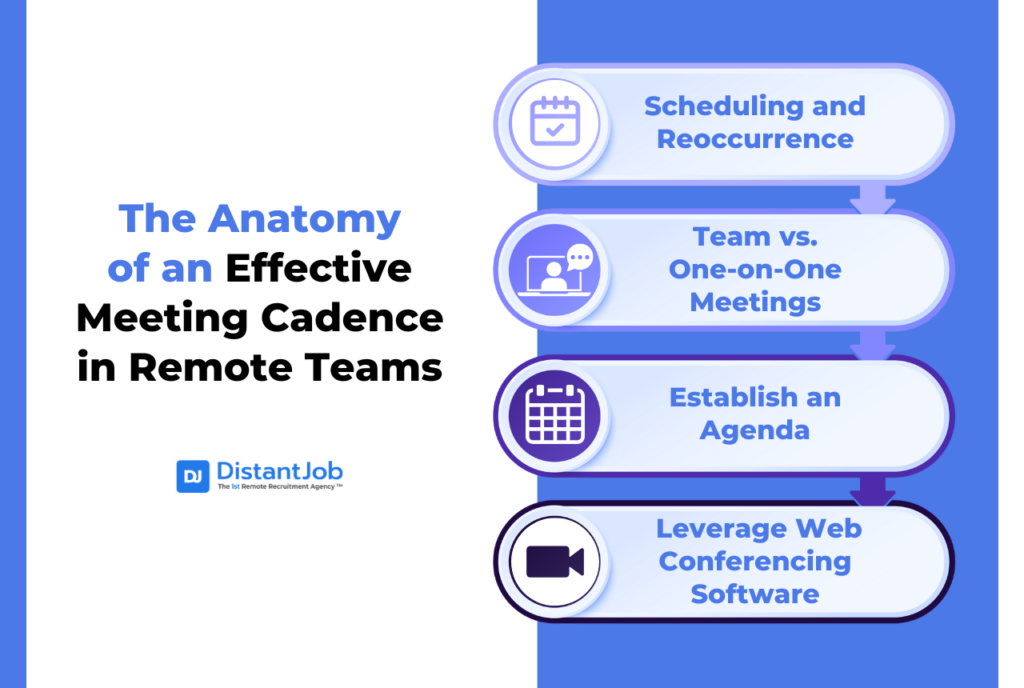Remember a few years ago when companies began transitioning from the traditional brick and mortar workplace to the more cost-effective remote workforce? At first glance, it seemed ideal—no more suits, long commutes, or bland office coffee. Fast forward to today, and while remote work has brought cost savings and flexibility, it has also highlighted critical challenges.
Remote teams lack the everyday face-to-face interactions of traditional offices, often leading to communication gaps, lower employee productivity,, poor resource management and higher employee turnover. Hence, the re-emphasis of the Business Cadence.
So, how can you create a business cadence that genuinely supports your remote team’s productivity and satisfaction?
The key is not simply scheduling meetings frequently but ensuring that every meeting has a clearly defined purpose and intended outcome. Set explicit expectations for daily, weekly, and monthly activities, clearly communicating these to your team. By structuring your interactions around specific goals and outcomes, you’ll foster a productive rhythm without sacrificing the freedom and flexibility that originally drew your employees to remote work.
Sometimes companies focus so much on delivering the final product or service, that they don’t realize that improving the workflow is just as important in order to grow their business. Microsoft is a great example. Building a business cadence around their workflow, really helped the Outlook design team to solve a problem with user experience.
The right business cadence will help you close communication gaps, streamline resource management, and keep your team engaged, productive, and connected—no matter where they’re working.
Let’s explore why having a business rhythm is key for handling remote teams and how it can boost your overall workflow.
What is a Cadence in Business?
A business cadence is defined as a rhythmic sequence. Within a business environment, a cadence refers to the frequency, format, and sequence with which a manager meets with the individuals on their team. While not a trendy, innovative workplace concept, the cadence has proven to pass the test of time as an effective means of managing resources. Especially in a remote-based staffing model.
Benefits of Using a Business Cadence
When correctly implemented into a management routine, the fundamental role of a cadence is to drive collaboration amongst team members, establish efficient workflow and lead to progression. The byproduct of this effort manifests itself through many benefits to an organization, such as:
- Stronger employee retention: By establishing a rhythm of work and communication between managers and employees, with clear expectations, goal discussion, and frequent feedback, employees feel more integrated and therefore, they can see a clear path to career progression.
- Higher level of team engagement: When that work rhythm is shared with a team, and even with the whole company, it becomes a crucial piece in the process of collaboration. When working at an office, team collaboration is often taken for granted. But in remote environments, there needs to be a bigger effort to communicate effectively and work together as a team. Having a cadence brings a sense of moving forward by clear processes.
- Cadences bring awareness to issues and facilitate change: Show me an organization that practices problem management, and I will show you a successful team with satisfied employees. Providing a forum for recognition of issues, identification of barriers and development of solutions allows people to feel empowered to succeed.
- Cadences affect the performance: Many leadership teams spend limited time together and even less on critical strategic discussions, often causing misalignment and poor decisions. A well-designed business cadence isn’t a cure-all but significantly reduces these risks. Christopher Fussell from McChrystal Group emphasizes: “Your rhythm should value purpose over habit, and effectiveness over efficiency. If it’s not driving growth, focus, and unity, change it.”
- Cadences improve the morale of remote-based employees: Yes, there are a multitude of benefits to working as a remote employee. However, many virtual workers develop the feeling of being isolated from their organization and out of touch. Providing a routine vehicle for engagement with the company and focusing on knowledge transfer is an ideal way to eliminate many of the causes for low employee morale.
In the following video, Wade Foster, Co-founder of Zapier delves into ways to achieve an effective cadence in different aspects of remote teams, such as:
- The remote hiring process.
- The onboarding of new hires.
- Periodic in-person meetings.
- Virtual team meetings.
- One on one meetings.
- Getting feedback from employees.
Why is Important to have a Meeting Cadence
Having a meeting cadence is crucial for remote teams. But not many people know what the meeting cadence meaning is.
Let me develop the concept by showing you some numbers:
Meetings are one of the most consuming tasks in an average employee’s workday. According to research by Cornerstone Dynamics, the time spent on meetings increased by 10% since the year 2000, and a standard meeting lasts between 31 and 60 minutes. But the most amazing fact about this is that only 37% of the meetings are run on a detailed agenda, which, if done, could decrease the meeting length by 80%.
Clearly, an employee would be much more productive if they held meetings with a clear agenda of topics and a time limit to not waste their time. Well, here comes the importance of a meeting cadence in business, which is basically a rhythm by which every meeting should go, establishing aspects, such as:
- Who’s attending and why (every attendant should have a concrete role in the meeting).
- Length (ideally, a maximum of 45 minutes).
- The exact agenda and topics ordered by importance.
- A result: an actionable set of tasks and a person assigned to perform them.
- Time for Q&As.
The Anatomy of an Effective Meeting Cadence in Remote Teams

Over the years I have tried many different formats and meeting types within my team cadences. In the end, I found out the best formula is to keep it simple and keep it consistent. Cadences do not need to be overly complicated, or cumbersome efforts to be effective. Establishing a rhythm tied to specific team performance objectives and keeping it constant has been my most effective strategy.
Within this approach, I have leveraged four primary components to the cadence process which enable me to be successful.
1. Scheduling and Reoccurrence
Take the time to find the optimal window for scheduling a meeting. Day of the week and time of day are essential factors in planning the cadence. Define the window which provides the best opportunity for focus and energy. Once you have it, book it and set it up for a lengthy reoccurrence to ensure it doesn’t fall off the schedule.
2. Team vs. One-on-One Meetings
Early on in my career, I used to stick with a weekly team cadence. However, over time I noticed that this forum did not allow me to focus on individual issues in much depth. Hence I started a blend of alternating between a team meeting one week followed by individual one-on-one sessions the next. What is important is that you understand the current needs of your team and balance the meeting type accordingly, especially in a remote setting.
3. Establish an Agenda
I have found the best way to ensure preparedness for a meeting is to provide an agenda in advance. Allow your team to be successful and see how they perform. Consider using an Issues and Actions log to document progress made on Agenda items.
4. Leverage Web Conferencing Software
I could fill up another whole article on this topic alone. I use a couple of different solutions that offer scheduling, voice, and video conferencing. Which medium I utilize for a meeting is typically dependent on the topic and need for a presentation.
How to Create a Cadence for Your Business
As a business manager, the best cadence isn’t one created from one guide or one manager’s personal philosophy. It is made by truly understanding the internal culture of a business, the team, the people’s strengths, and even their location.
When I create my cadence, my first question is always: “What do I need to provide the people in my company with the infrastructure and connectivity to make them productive and happy?”
Regardless, here are my core philosophies about creating a cadence:
1. Create a Flexible Cadence: Don’t take away the freedom that brought people to work remotely in the first place.
2. Define Objectives and Goals for Every Get- Together: Each meeting or experience should have clear objectives and deliverables.
3. Create Regular Check-Ins and Processes: Make sure that both are a part of the system, not so much that it will annoy people and make them feel trapped but enough for staff to know that the company cares and is involved.
4. Get Feedback: Communication is a two-way street. Ensure that employees feel comfortable asking for changes to the cadence.
As you can see, the best cadence is the one that people want to follow because it provides more productivity and builds team morale, not the one where people are forced to stare at the clock as they go through the motions.
Conclusion
In summary, with a well-implemented cadence, you can keep up steady work, help people work together, and make your team work better—when everyone’s working from home. But it’s just as important to find the right people to join in and add to this rhythm.
That’s where DistantJob steps in. We’re experts at finding top remote workers who not only have the tech skills you need but also fit right into your company’s way of doing things. If you want to take your remote team to new heights, let us help you find the right people to make it happen! Get in touch now.





